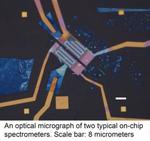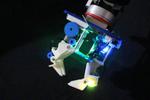Other

“Primordial black holes created in the first instants after the Big Bang — tiny ones smaller than the head of a pin and supermassive ones covering billions of miles — may account for all of the dark matter in the universe. That …

“Octopus tentacles can move in many directions, but also form stiff joint-like structures for more precise movements. Caterpillars can travel by using inchworm movements, as well as coil up and propel themselves away from predators. Such capabilities allow organisms to …

“As scientists prepare for crewed research missions to nearby planets and moons, they’ve identified a need for something beyond rovers and rockets. They need accurate weather forecasts. Without them, any trip to the surface may be one dust storm …

“For years engineers have struggled to create in a usable form a structure known as a gyroid, a peculiar multi-surface object that can both reflect light and conduct electricity and just may hold the key to a host of photonics-related …

“Three years ago, a team of astronomers led by Yale’s Pieter van Dokkum surprised the scientific community with the discovery of a far-off galaxy that contained little or no dark matter. The discovery, made using NASA’s Hubble Space …

“An international team of researchers has developed a mid-infrared spectrometer smaller than the diameter of a human hair. With potential applications that range from detecting greenhouse gases to making self-driving vehicles safer, there has been a great deal of interest …

“Humans use all surfaces of the hand for contact-rich manipulation. Robot hands, in contrast, typically use only the fingertips, which can limit dexterity. In a new study from the lab of Aaron Dollar, professor of mechanical engineering & materials science & computer …

“Plastics are one of the world’s largest polluters, taking hundreds of years to degrade in nature. A research team, led by YSE professor Yuan Yao and Liangbing Hu from the University of Maryland, has created a high-quality bioplastic from …

“Random numbers are increasingly important to our digitally connected world, with applications that include e-commerce, cryptography, and cloud computing. Producing a large amount of truly random numbers quickly, though, is a challenge. To speed things up, a team of researchers …

“Stretchable electronic circuits are critical for soft robotics, wearable technologies, and biomedical applications. The current ways of making them, though, have limited their potential. A team of researchers in the Yale lab of Rebecca Kramer-Bottiglio, the John J. Lee Assistant …
